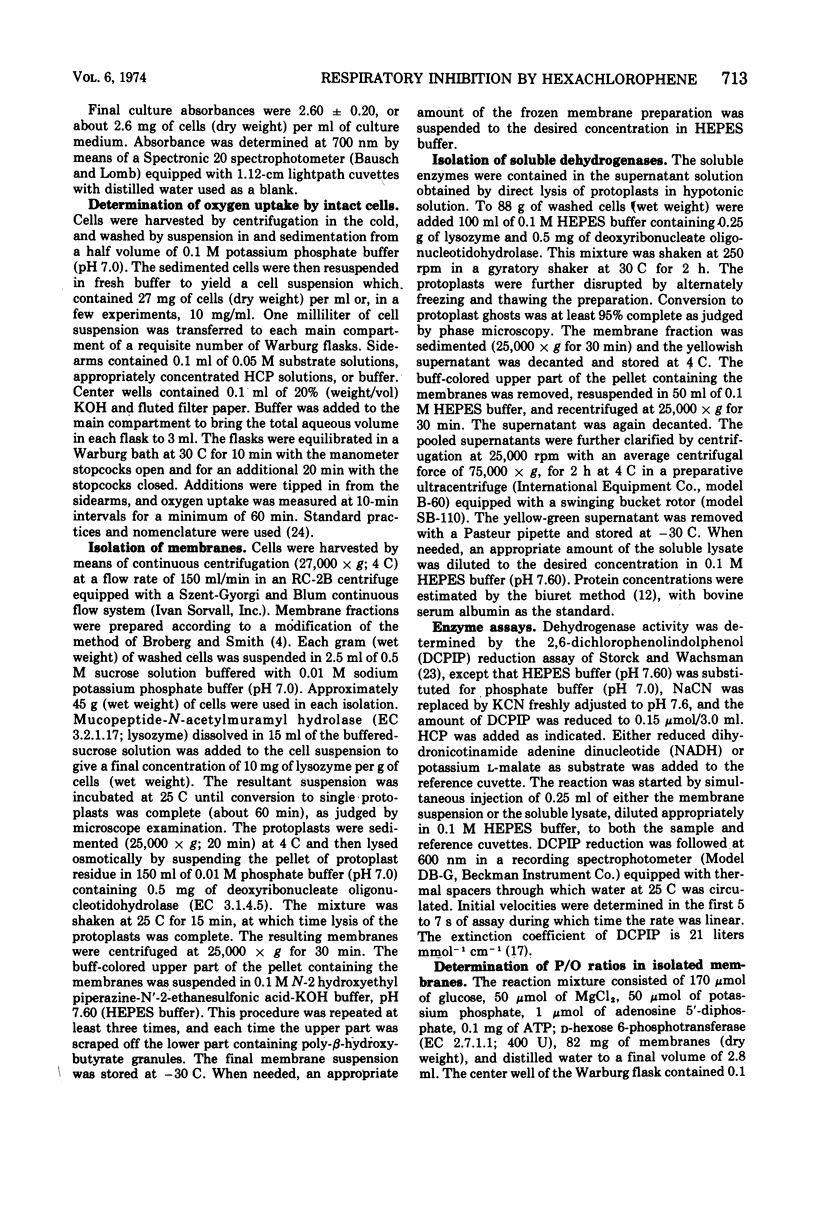Abstract
Hexachlorophene (HCP) inhibits both endogenous and exogenous respiration (oxygen uptake) in Bacillus megaterium, without sparing by any of several substrates. The inhibition is maximal when the cells are treated with 8 μg of HCP per mg of cells (dry weight), which corresponds to the minimal lethal dose. Levels as low as 2 μg/mg are inhibitory but not lethal. HCP also inhibits the respiration of isolated B. megaterium membranes and can act on several components of the electron transport chain in the membranes and on soluble enzymes. Although both forms of nicotinamide adenine dinucleotide, reduced form dehydrogenase and malic dehydrogenase are inhibited by HCP, they are less susceptible than is oxygen uptake. The site of maximal sensitivity is nearer the terminal electron acceptor, but the exact location depends on the cytochrome composition of the membranes. If cytochromes b1, a, and a3 are present, but not o, HCP inhibits electron transport on the substrate side of cytochrome b1; if cytochromes b1, a3, and o are present, but not a, the inhibition occurs on the oxygen side of cytochrome b1. Exogenous menadione, an analogue of menaquinone, reverses the inhibition in both circumstances. The primary lethal action of HCP thus appears to be respiratory inhibition at a site within the membrane-bound part of the electron transport chain.
Full text
PDF









Selected References
These references are in PubMed. This may not be the complete list of references from this article.
- ADAMS J. B., HOBBS M. The mode of action of chlorinated bisphenol antibacterials. II. Biological studies. J Pharm Pharmacol. 1958 Aug;10(8):516–521. doi: 10.1111/j.2042-7158.1958.tb10336.x. [DOI] [PubMed] [Google Scholar]
- Asano A., Cohen N. S., Baker R. F., Brodie A. F. Orientation of the cell membrane in ghosts and electron transport particles of Mycobacterium phlei. J Biol Chem. 1973 May 25;248(10):3386–3397. [PubMed] [Google Scholar]
- BECK E. S., LINDSTROM E. S. The oxidative metabolism of Bacillus cereus. J Bacteriol. 1955 Sep;70(3):335–338. doi: 10.1128/jb.70.3.335-338.1955. [DOI] [PMC free article] [PubMed] [Google Scholar]
- Broberg P. L., Smith L. The cytochrome system of Bacillus megaterium KM. The presence and some properties of two CO-binding cytochromes. Biochim Biophys Acta. 1967 May 9;131(3):479–489. doi: 10.1016/0005-2728(67)90007-2. [DOI] [PubMed] [Google Scholar]
- Broberg P., Welsch M., Smith L. Glucose dehydrogenase of Bacillus megaterium KM. Coupling of the cytoplasmic enzyme with membrane-bound cytochromes. Biochim Biophys Acta. 1969 Feb 25;172(2):205–215. doi: 10.1016/0005-2728(69)90064-4. [DOI] [PubMed] [Google Scholar]
- Caldwell R. S., Nakaue H. S., Buhler D. R. Biochemical lesion in rat liver mitochondria induced by hexachlorophene. Biochem Pharmacol. 1972 Sep 15;21(18):2425–2441. doi: 10.1016/0006-2952(72)90413-3. [DOI] [PubMed] [Google Scholar]
- Cammer W., Moore C. L. The effect of hexachlorophene on the respiration of brain and liver mitochondria. Biochem Biophys Res Commun. 1972 Mar 10;46(5):1887–1894. doi: 10.1016/0006-291x(72)90066-6. [DOI] [PubMed] [Google Scholar]
- Corner T. R., Joswick H. L., Silvernale J. N., Gerhardt P. Antimicrobial actions of hexachlorophene: lysis and fixation of bacterial protoplasts. J Bacteriol. 1971 Oct;108(1):501–507. doi: 10.1128/jb.108.1.501-507.1971. [DOI] [PMC free article] [PubMed] [Google Scholar]
- Eisenberg R. C. Reconstitution of Micrococcus lysodeikticus reduced nicotinamide adenine dinucleotide and L-malate dehydrogenases with dehydrogenase-depleted membrane residues: a basis for restoration of oxidase activities. J Bacteriol. 1972 Oct;112(1):445–452. doi: 10.1128/jb.112.1.445-452.1972. [DOI] [PMC free article] [PubMed] [Google Scholar]
- Frade R., Chaix P. Influence du pH sur la synthése de l'oxidase (cytochrome a3) chez Bacillus, microorganism thermophile, capable d' "adaptation respiratoire". Biochim Biophys Acta. 1973 Dec 14;325(3):424–432. doi: 10.1016/0005-2728(73)90203-x. [DOI] [PubMed] [Google Scholar]
- GOULD B. S., BOSNIAK M. A., NEIDLEMAN S., GATT S. Effect of hexachlorophene and related bisphenolic compounds on the dehydrogenases and cytochrome system of Bacillus subtilis and Escherichia coli. Arch Biochem Biophys. 1953 Jun;44(2):284–297. doi: 10.1016/0003-9861(53)90046-0. [DOI] [PubMed] [Google Scholar]
- GOULD B. S., FRIGERIO N. A., LEBOWITZ W. B. The action of bisphenolic compounds on succinoxidase, cytochrome C oxidase and lactic dehydrogenase of animal tissue. Arch Biochem Biophys. 1955 Jun;56(2):476–486. doi: 10.1016/0003-9861(55)90268-x. [DOI] [PubMed] [Google Scholar]
- Haque R., Buhler D. R. A proton magnetic resonance study of the interaction of hexachlorophene with amides and polypeptides. J Am Chem Soc. 1972 Mar 22;94(6):1824–1828. doi: 10.1021/ja00761a005. [DOI] [PubMed] [Google Scholar]
- Joswick H. L., Corner T. R., Silvernale J. N., Gerhardt P. Antimicrobial actions of hexachlorophene: release of cytoplasmic materials. J Bacteriol. 1971 Oct;108(1):492–500. doi: 10.1128/jb.108.1.492-500.1971. [DOI] [PMC free article] [PubMed] [Google Scholar]
- Kröger A., Dadák V. On the role of quinones in bacterial electron transport. The respiratory system of Bacillus megaterium. Eur J Biochem. 1969 Dec;11(2):328–340. doi: 10.1111/j.1432-1033.1969.tb00776.x. [DOI] [PubMed] [Google Scholar]
- Revsin B., Marquez E. D., Brodie A. F. Cytochromes from Mycobacterium phlei. II. Ascorbate reduction of an isolated cytochrome (a+a3) (o) complex. Arch Biochem Biophys. 1970 Feb;136(2):563–573. doi: 10.1016/0003-9861(70)90228-6. [DOI] [PubMed] [Google Scholar]
- SMITH L. An investigation of cytochrome c oxidase activity in bacteria. Arch Biochem Biophys. 1954 Jun;50(2):315–321. doi: 10.1016/0003-9861(54)90046-6. [DOI] [PubMed] [Google Scholar]
- STORCK R., WACHSMAN J. T. Enzyme localization in Bacillus megaterium. J Bacteriol. 1957 Jun;73(6):784–790. doi: 10.1128/jb.73.6.784-790.1957. [DOI] [PMC free article] [PubMed] [Google Scholar]
- Salton M. R. Bacterial membranes. CRC Crit Rev Microbiol. 1971 May;1(1):161–197. doi: 10.3109/10408417109104480. [DOI] [PubMed] [Google Scholar]
- Silvernale J. N., Joswick H. L., Corner T. R., Gerhardt P. Antimicrobial actions of hexachlorophene: cytological manifestations. J Bacteriol. 1971 Oct;108(1):482–491. doi: 10.1128/jb.108.1.482-491.1971. [DOI] [PMC free article] [PubMed] [Google Scholar]
- WEIBULL C., BECKMAN H., BERGSTROM L. Localization of enzymes in Bacillus megaterium, strain M. J Gen Microbiol. 1959 Jun;20(3):519–531. doi: 10.1099/00221287-20-3-519. [DOI] [PubMed] [Google Scholar]
- White D. C., Sinclair P. R. Branched electron-transport systems in bacteria. Adv Microb Physiol. 1971;5:173–211. doi: 10.1016/s0065-2911(08)60407-5. [DOI] [PubMed] [Google Scholar]
- Yudkin M. D. Isolation and analysis of the protoplast membrane of Bacillus megaterium. Biochem J. 1966 Mar;98(3):923–928. doi: 10.1042/bj0980923. [DOI] [PMC free article] [PubMed] [Google Scholar]


